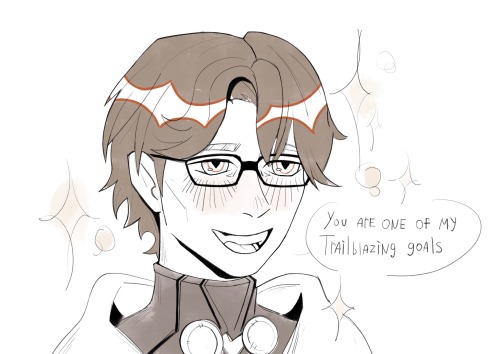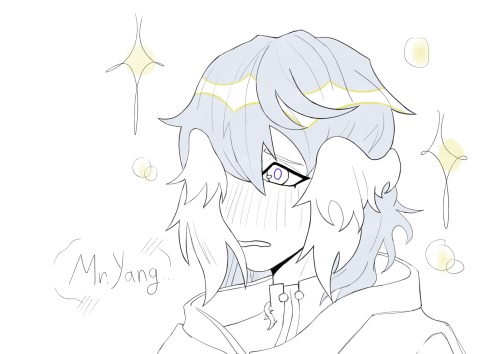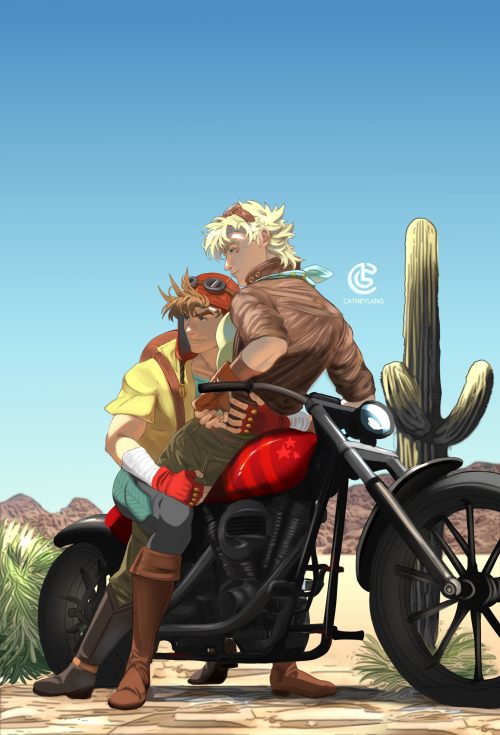AI Defenders Will Make It Seem As If Art Is This Gatekept Pastime That Only The Most Elite Can Partake
AI defenders will make it seem as if art is this gatekept pastime that only the most elite can partake in and they’re making it possible for the “normies” to create meanwhile one of the most memorable pieces of recent art I’ve ever seen is “My son’s drawing of safe”

More Posts from Mistyfragrance and Others

I am going to run them over (ASMR)


So a free tool called GLAZE has been developed that allows artists to cloak their artwork so it can't be mimicked by AI art tools.
AI art bros are big mad about it.


Shipped them just recently, doodle


GEMINI ★
secret santa gift for @nokonyu



I think momo has a lot of fun messing w her powers (consciously or otherwise)
Looking back at my last comic after doing the quest is so funny 😭 literally the exact opposite happened

Transmasculinity and queer sexuality in the works of Ikeda Riyoko

Content Warning: Discussion of transphobia and suicide
Spoilers for Dear Brother, The Rose of Versailles, and Claudine
Ikeda Riyoko—perhaps the most famous member of the “year 24 group” that played a large part in creating the foundations of the shoujo manga genre—is often credited with laying the groundwork for depictions of queer characters in shoujo, and in particular with creating the archetype of the gender-bending heartthrob heroine, or “girl prince.” Building on earlier representations of butch or transmasculine characters in early shoujo manga such as Princess Knight, and the Takarazuka theater tradition of the otokoyaku male role actor, Ikeda’s enormously popular gender non-conforming heroes—Lady Oscar from The Rose of Versailles, Rei from Dear Brother, Julius from the Window of Orpheus, and the titular character of Claudine—helped to establish that there was a major mainstream audience excited to cheer for a hotheaded, androgynous tomboy with a heart of gold. Lady Oscar in particular has fingerprints all over the history of anime and manga, from a gender-bending cameo in Pokémon to serving as the inspiration for iconic characters like Tenjou Utena.
When I first read The Rose of Versailles last year, I expected its depictions of queer and transmasculine characters to be somewhat limited—after all, the comic was written for mainstream audiences and a mainstream publisher in the 1970s. But across Ikeda’s work, I was deeply surprised with the level of care and nuance with which Ikeda approaches transmasculine love stories. While there is obviously a lot about Ikeda’s portrayal of transmasculine characters that feels dated to modern audiences (for example, her comics often do fall back on “biological” ideas of women’s weakness and emotionality, and sometimes psychologize her character’s genders in uncomfortable ways), I was surprised by how much of these comics still hit for me today. What makes them work for me is both the extreme pathos with which Ikeda writes transmasculine character’s experiences of rejection—and, at rare moments, gender euphoria —but also the fact that her trans characters are not simply given a one-size fits all born-in-the-wrong-body narrative. Instead, they are each portrayed as unique individuals with varied personal relationships to their gender, their sexuality, and the historical context of the society they live in.
Read it at Anime Feminist!


warrior finds a rabid thing along his path; decides to keep it and train it

🏍️💨🫧🌟
-
 hallucenati liked this · 1 week ago
hallucenati liked this · 1 week ago -
 wind-up-boy-toy reblogged this · 1 week ago
wind-up-boy-toy reblogged this · 1 week ago -
 quetiapinnapark liked this · 1 week ago
quetiapinnapark liked this · 1 week ago -
 glueandmorphemes liked this · 1 week ago
glueandmorphemes liked this · 1 week ago -
 cherrylusstuff liked this · 1 week ago
cherrylusstuff liked this · 1 week ago -
 sturgeonz liked this · 1 week ago
sturgeonz liked this · 1 week ago -
 vin-of-the-void reblogged this · 1 week ago
vin-of-the-void reblogged this · 1 week ago -
 vin-of-the-void liked this · 1 week ago
vin-of-the-void liked this · 1 week ago -
 awasteofexy-gen liked this · 1 week ago
awasteofexy-gen liked this · 1 week ago -
 itsleapfrog liked this · 1 week ago
itsleapfrog liked this · 1 week ago -
 beep-boop-blerp reblogged this · 1 week ago
beep-boop-blerp reblogged this · 1 week ago -
 aceofspades42 reblogged this · 1 week ago
aceofspades42 reblogged this · 1 week ago -
 aceofspades42 liked this · 1 week ago
aceofspades42 liked this · 1 week ago -
 things-are-heating-up reblogged this · 1 week ago
things-are-heating-up reblogged this · 1 week ago -
 here-am-i-sitting-in-a-tin-can reblogged this · 1 week ago
here-am-i-sitting-in-a-tin-can reblogged this · 1 week ago -
 rainbowpeach123 reblogged this · 1 week ago
rainbowpeach123 reblogged this · 1 week ago -
 iovebeam reblogged this · 1 week ago
iovebeam reblogged this · 1 week ago -
 wizardwatch liked this · 1 week ago
wizardwatch liked this · 1 week ago -
 raphayella liked this · 1 week ago
raphayella liked this · 1 week ago -
 kayd333 reblogged this · 1 week ago
kayd333 reblogged this · 1 week ago -
 kayd333 liked this · 1 week ago
kayd333 liked this · 1 week ago -
 pishposhbagosh reblogged this · 1 week ago
pishposhbagosh reblogged this · 1 week ago -
 henryhodgson reblogged this · 1 week ago
henryhodgson reblogged this · 1 week ago -
 ewoobutnooriginalcontent reblogged this · 1 week ago
ewoobutnooriginalcontent reblogged this · 1 week ago -
 schrodingerkilledmycat liked this · 1 week ago
schrodingerkilledmycat liked this · 1 week ago -
 nihilistic-god reblogged this · 1 week ago
nihilistic-god reblogged this · 1 week ago -
 nihilistic-god liked this · 1 week ago
nihilistic-god liked this · 1 week ago -
 ezras-left-thumb liked this · 1 week ago
ezras-left-thumb liked this · 1 week ago -
 poppypiqueerer liked this · 1 week ago
poppypiqueerer liked this · 1 week ago -
 cockatude liked this · 1 week ago
cockatude liked this · 1 week ago -
 lutraossa liked this · 1 week ago
lutraossa liked this · 1 week ago -
 galaxyremix131 liked this · 1 week ago
galaxyremix131 liked this · 1 week ago -
 peeledstrawberry liked this · 1 week ago
peeledstrawberry liked this · 1 week ago -
 zenithofdisaster liked this · 1 week ago
zenithofdisaster liked this · 1 week ago -
 untitledgirl5173 reblogged this · 1 week ago
untitledgirl5173 reblogged this · 1 week ago -
 galraluver liked this · 1 week ago
galraluver liked this · 1 week ago -
 styxxus liked this · 1 week ago
styxxus liked this · 1 week ago -
 jamsofdeath0 reblogged this · 1 week ago
jamsofdeath0 reblogged this · 1 week ago -
 icefang111 reblogged this · 1 week ago
icefang111 reblogged this · 1 week ago -
 allihearisradiogaga liked this · 1 week ago
allihearisradiogaga liked this · 1 week ago -
 scatterbrainedgremlin reblogged this · 1 week ago
scatterbrainedgremlin reblogged this · 1 week ago -
 visorak reblogged this · 1 week ago
visorak reblogged this · 1 week ago -
 visorak liked this · 1 week ago
visorak liked this · 1 week ago -
 lizwuzthere reblogged this · 1 week ago
lizwuzthere reblogged this · 1 week ago -
 dadabobo liked this · 1 week ago
dadabobo liked this · 1 week ago -
 astridweper liked this · 1 week ago
astridweper liked this · 1 week ago -
 seaweed-official reblogged this · 1 week ago
seaweed-official reblogged this · 1 week ago -
 seaweed-official liked this · 1 week ago
seaweed-official liked this · 1 week ago -
 seismic-tartness liked this · 1 week ago
seismic-tartness liked this · 1 week ago

she/they🔔 main account!! i talk about everything!! i actually dont bc im shy but whatevs
72 posts